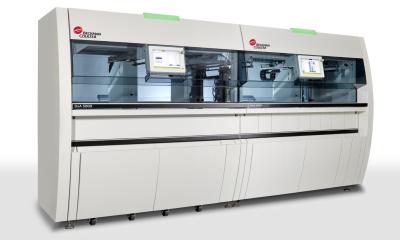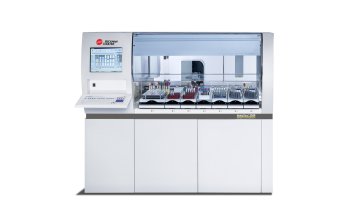Article • Blood poisoning
Exploring the importance and challenges of early sepsis diagnosis
On the occasion of this year's World Sepsis Day, we spoke with Elena Sukhacheva, Ph.D., about the status quo and outlook on sepsis diagnostics. The expert takes a magnified look at diagnosing sepsis, namely the importance of doing so and the challenges that many physicians face.
Image source: Shutterstock/Phonlamai Photo
Why is it so important to diagnose sepsis in its early stages?

"Sepsis is one of the most deadly and costly medical conditions physicians and hospitals must face. In fact, statistics show that sepsis is the third leading cause of death in the U.S.1. Mortality rates for sepsis is extremely high—approximately 25-30%—with more individuals dying of sepsis than prostate cancer, breast cancer, and HIV combined 2,3. Hospitalizations due to sepsis cost the healthcare system more than any other condition in the U.S.,4 with a total annual cost greater than 24 billion dollars5.
According to data from the Healthcare Cost and Utilisation Project (HCUP), there was an increase both in the number of cases of sepsis, and the costs associated with sepsis between 2000 and 20096. With sepsis as their primary diagnosis, the mean length of a patient’s hospital stay was close to nine days in 2009, with an average cost per entire stay at $18,500 6.
Early detection of sepsis is critical, as a delay in antibiotic treatment has been documented to result in increased mortality, with a 7.6% increase in death for patients with severe sepsis and septic shock every hour antibiotic administration is delayed7. Therefore, the earlier sepsis is recognized and the earlier the treatment starts, the better the outcome for the patient and the lower the cost that can be expected to be borne by the healthcare system."
What are the challenges of rapid sepsis diagnostic?
"The main challenge of timely diagnosis is that sepsis may manifest in dramatically different ways. Sepsis may affect anyone. For example, a young patient acquiring an infection from an appendectomy, for whom a dysregulated immune response leads to organ failure and death, or a patient undergoing aggressive cancer treatments, whose immune system is unable to fight infection due to immunosuppression. In both cases, the diagnosis would be “sepsis”, but symptoms in these two patients might look very different.
It is also important to mention that most (two-thirds) of patients diagnosed with sepsis enter the healthcare system through A&E8. Therefore, it is very important to ensure that efficient sepsis detection practices are used at this entry point. Symptoms are not always clear, so in practice, clinicians only order a test for sepsis when symptoms become clearer in the patient and they are more obviously septic. This delay in the diagnosis and treatment for patients with ambiguous presentation often results in a worse outcome9."
How is sepsis currently diagnosed? What are the limitations of these methods?
Diagnosing sepsis early is very challenging, because symptoms may not be obvious and clear at the time at which the patient presents at the hospital
Elena Sukhacheva
"Before we talk about diagnosing sepsis, let’s define what sepsis is. As you may know, for many years we had the so-called sepsis-2 definition, which was introduced in 199210. That definition of sepsis was based on the presence of at least 2 SIRS criteria (systemic inflammatory response syndrome) and either a clinically suspected or proven infection. In 2016, a new definition was established for sepsis, and today, sepsis is defined as a life-threatening organ dysfunction caused by a dysregulated host response to infection11. Deaths from sepsis result, not from the infection itself, but from dysregulated immunity and organ dysfunction, which makes it impossible to efficiently fight against the infection.
Practically speaking, clinicians may use SIRS criteria (if they are still using sepsis-2) or the SOFA score (sequential organ failure assessment, if they use the sepsis-3 definition) to diagnose sepsis. Additionally, laboratory tests are used to test for infection and help confirm a suspicion of sepsis 12,13,14; for example, by measuring the patient's WBC (white blood cell) count, Procalcitonin, C-Reactive Protein, Interleukin-6 or presepsin levels, or culturing body fluids such as blood or urine for infectious organisms. While positive cultures may be diagnostic of infection, none of these tests can definitively confirm a diagnosis of sepsis, so clinicians must rely on all the clinical and laboratory information available together to diagnose sepsis.
Additionally, it is important to note that not all tests are routinely performed for all patients, but only ordered when a clinician suspects infection or sepsis. Therefore, diagnosing sepsis early is very challenging, because symptoms may not be obvious and clear at the time at which the patient presents at the hospital."
Recommended article

Sponsored • Hematology
Early sepsis indicator helps identifying patients at risk
The critical element of testing for sepsis lies not so much in the location but in the timing and rapidity of results, according to Professor Jeannine T. Holden from Beckman Coulter Early identification enables treatment protocols to be delivered more quickly, offering better patient outcomes. Those most at risk, suggests Holden, are not patients within the intensive care unit – who are already…
Which new ways of diagnosing are there?
"Recently, Beckman Coulter brought to the market new sepsis biomarker, Early Sepsis Indicator, the only FDA-cleared hematologic biomarker that is available to be automatically reported as part of a complete blood count (CBC) with differential test for adults entering through the A&E or emergency department. The new sepsis biomarker is available exclusively on the Beckman Coulter hematology analyser, DxH 900. The parameter, Monocyte Distribution Width (MDW), is based on morphological changes in monocytes in response to infection. Since the Early Sepsis Indicator is included as part of a CBC-Diff analysis, it does not require additional blood to be drawn or a special order, and it is automatically reported for all adult patients.
Sepsis is so complex that most probably the ideal single sepsis biomarker does not exist, and the most efficient way in early sepsis detection is the combination of several sepsis biomarkers
Elena Sukhacheva
Three scientific papers have already demonstrated the analytical performance of the Early Sepsis Indicator. The first results about early sepsis detection in ED with Monocyte Distribution width were published in the journal, Chest in 201715. This study, which was conducted by Ohio State University, demonstrated that an elevated MDW value was able to discriminate sepsis from non-sepsis (according to sepsis-2 criteria) with a Receiver-Operator Curve Area Under the Curve (AUC) of 0.79, 77% sensitivity and 73% specificity. The study also analysed the performance of the WBC count and the combination of WBC and MDW. When MDW and WBC values were combined, they produced an AUC of 0.89, which was significantly higher than the AUC for each individual parameter [WBC AUC was 0.74].
Another study published in Critical Care Medicine included more than 2,100 consecutive adult emergency-department patients, and was conducted in three U.S. University Hospitals. This clinical trial confirmed the discriminatory capacity of MDW alone, and MDW with WBC16.
A very recent paper from Journal of Intensive Care demonstrated that MDW is complementary to SIRS and qSOFA parameters, in essence, serving as a fifth SIRS criteria or a fourth qSOFA criteria, to enhance the early detection of sepsis in the ED.17"
What will be the next steps in early sepsis detection?
"Sepsis is so complex that most probably the ideal single sepsis biomarker does not exist, and the most efficient way in early sepsis detection is the combination of several sepsis biomarkers18, but this would require joint efforts from researchers and clinicians."
Profile:
Dr. Elena Sukhacheva has more than 15 years of experience in the diagnostic industry and is director of medical and scientific affairs, with global responsibility for Beckman Coulter's research in the field of laboratory hematology. She is a member of the American Society of Hematology (ASH) and International Society of Laboratory Hematology (ISLH), and corporate representative at the International Committee on Standardization in Hematology (ICSH). Dr. Sukhacheva is a graduate of Lomonosov Moscow State University and holds a Ph.D. in molecular biology from Shemyakin-Ovchinnikov Institute of Bioorganic Chemistry, Russian Academy of Sciences. She has research experience in various subjects, including Hematology, Immunochemistry, and the development of diagnostics test system for research and clinical applications. She has vast experience the fields of laboratory flow cytometry and hematology, which has led to the publishing of more than 50 research papers and a patent involving high-sensitivity parameters for the detection of vitamin B12 or folate deficiencies and the method of use.
References:
1. Vidant Beaufort Hospital “The third-leading cause of death: sepsis” http://www.thewashingtondailynews.com/2017/07/08/the-third-leading-cause-of-death-sepsis/, July 8, 2017. Accessed March 19, 2018.
4. Sepsis Alliance. “Critical Fact Sheet.” Sepsis.org. Accessed January 15, 2018.
5. Torio C, Moore B. “National Inpatient Hospital Costs: The Most Expensive Conditions by Payer.” http://www.hcup-us.ahrq.gov/reports/statbriefs/sb204-Most-Expensive-Hospital-Conditions.pdf, May 2016. Accessed January 15, 2018.
18. Pierrakos C, Vincent JL. Sepsis biomarkers: a review. Critical Care 2010, 14:R15.
14.09.2020











